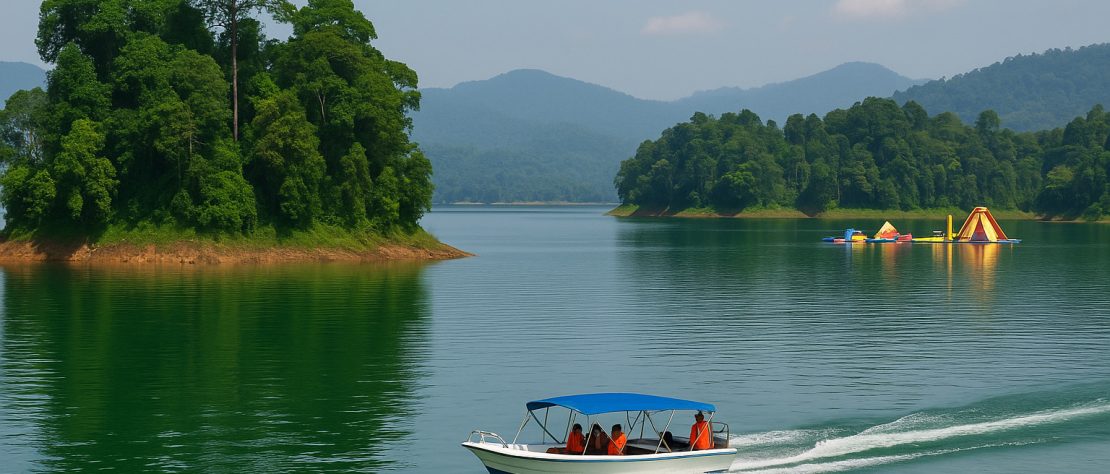Kenyir Lake, the largest man-made lake in Southeast Asia, stretches across Terengganu, Malaysia, and offers over 340 islands waiting to be experienced by boat. These islands, once hilltops before the creation of the lake, each hold their own features, from medicinal herb gardens and cascading waterfalls to sanctuaries for elephants and rare fish. If you’re plotting a boat trip through this expansive freshwater wonder, certain islands stand out for their natural beauty, recreational offerings, and ecological interest.
Here’s a breakdown of the most worthwhile islands to include in your Kenyir Lake itinerary.
1. Pulau Gawi – The Starting Point with a Little of Everything
Pulau Gawi often acts as the base camp for many lake tours. It’s not just a transport hub—it holds two of Kenyir’s signature attractions:
- Herbal Park: With over 200 traditional herbal plants like Tongkat Ali and Kacip Fatimah, the park offers visitors a guided walkthrough of Malaysia’s ethnobotanical knowledge. Every plant label reads like a natural remedy cabinet, with explanations of uses for energy, fertility, and healing.
- Kenyir Elephant Conservation Village (KECV): A sanctuary for rescued elephants, this center educates visitors on conservation while offering interaction opportunities such as feeding and bathing sessions. It’s a key stop for families and wildlife fans.
Pulau Gawi is best visited early in the trip as many boat tours begin here. The island’s facilities, parking, and food stalls make it a practical launchpad.
2. Pulau Saok – Greenery and Waterfalls in Every Direction
Pulau Saok is where the rainforest shows off. Boat passengers often notice the shift in temperature and ambient sound as they approach—the air cools, and bird calls echo between thick canopies. This island is less structured than Gawi, which adds to its charm.
- Saok Waterfalls: Easily reached by a short trek, these falls spill across terraced rocks, creating natural plunge pools. The sound of rushing water and chirping cicadas creates an immersive backdrop for a mid-day stop.
- Rest Spots and Trails: Wooden benches dot the pathways, and shaded walking trails give the impression of an untouched landscape. This is an ideal location for travelers seeking quiet over crowds.
3. Pulau Poh – Water Park Meets Jungle
Pulau Poh provides a contrast to the more serene islands. Here, nature blends with leisure through the Kenyir Water Park, a floating attraction built over the lake’s surface.
- Water Slides and Obstacle Courses: This area is designed for fun, especially for families with children. Bright inflatables, climbing stations, and splash zones make Pulau Poh a high-energy destination.
- Viewing Platforms: Despite the modern amenities, the island doesn’t ignore its setting. Elevated viewpoints allow panoramic vistas of the lake’s expanse, blending the excitement of a theme park with tranquil jungle surroundings.
Visitors often pair Pulau Poh with quieter stops to balance their day between activity and rest.
4. Themed Park Islands – Micro-Habitats Worth the Stop
Several smaller islands have been developed to highlight specific natural features, creating educational mini-parks across the lake.
- Bird Park Island: Home to tropical and migratory species, this aviary gives boaters a chance to spot hornbills, eagles, and kingfishers up close. The park is built with open-air enclosures and canopy walks.
- Butterfly Park Island: Colorful winged insects populate this tropical nursery. It’s a photogenic stop, with flowering plants, walking trails, and breeding programs on display.
- Tropical Park Island: Focused on biodiversity, this location features curated plant zones, each labeled with species origin and ecological roles.
These theme-based islands are often short stops but add depth and variety to the trip.
5. Kelah Sanctuary – Swim with the Malayan Mahseer
Though technically not a full island experience, the Kelah Sanctuary is only accessible by boat and deserves a highlight.
- Thousands of Mahseer: Known locally as ‘ikan kelah,’ these fish are revered for their rarity and clean-water habitat needs. At the sanctuary, visitors can swim in protected pools where these fish freely school around.
- Strict Conservation Protocols: Shoes and lotions are forbidden in the water. Fish feeding is regulated, and guides monitor all activity to protect the species.
This stop provides a meaningful look at local conservation practices and aquatic biodiversity.
6. Beyond the Islands: Waterfalls and Caves Along the Way
As your boat weaves between destinations, other natural attractions are accessible without fixed island boundaries:
- Lata Lasir Waterfall: A short uphill trek from the boat jetty rewards hikers with panoramic views and a cool spray from the waterfall’s summit. The trek takes about 30–40 minutes and features rope railings for support.
- Lata Soak: A gentler cascade perfect for a picnic or swim.
- Gua Bewah and Gua Taat: These caves rise from the limestone cliffs lining the lake. Rich in archeological significance, they feature stalactites, ancient tools, and even skeletal remains. Gua Bewah is lit for guided tours, while Gua Taat retains a more rugged, torch-in-hand format.
These features break up the island-to-island rhythm with moments of geological and visual contrast.
Planning Your Route
- Start at Pengkalan Gawi Jetty: All tours typically begin here. Speedboats and tour operators are stationed at this point. Booking a private boat allows more flexibility in timing and stops.
- Tour Duration: Most island-hopping itineraries run half-day or full-day. Longer tours often include Lata Lasir or the Kelah Sanctuary.
- What to Bring:
- Water-safe footwear for trekking and wading
- Sunscreen and bug repellent
- Cash for entrance fees and snacks
- Dry bags for electronics
- Best Time to Go: Dry season months (March to September) reduce the risk of heavy rainfall, ensuring smoother boat rides and clearer waterfall access.
Final Thoughts
Kenyir Lake’s islands each serve a different interest—botany, conservation, recreation, or just raw scenery. Boating between them allows for a dynamic journey shaped by both nature and culture. Whether it’s feeding elephants on Pulau Gawi or floating among schools of mahseer at the sanctuary, this part of Malaysia offers lake travel with depth and variation few others can match.
